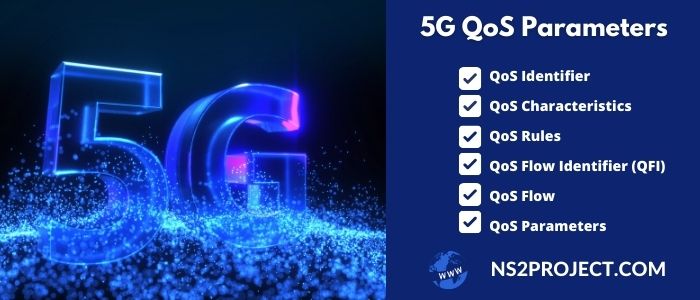In general, 5G Network is defined as the (5G QoS Parameters) Quality of service terms of three primary models such as mMTC, U-MTC, and xMBB, which are highly utilized for commercial purposes. The main objective of these models is to build and earn user trust over the deployed networks. Moreover, the Quality of the network can be classified based on the following categories,
- Quality of Service (QoS) & Quality of Experience (QoE)
- Performance of Network
As a matter of fact, the future 5G networks assure to give maximum Quality of service (QoS) based on different respects of requirements. Also, it offers various kinds of benefits over different case studies of QoS. We can now see a list of QoS-related terms commonly used in the 5G network.
5G QoS Terminologies
- QoS Identifier
- Points out the set of QoS characteristics for detecting QoS flow
- QoS Characteristics
- Every QoS flow is verified by the metrics such as PER, resource type, maximum burst size, priority, etc.
- QoS Rules
- Priorities and classify the operations, then create uplink traffic to work with a QoS flow.
- QoS Flow Identifier (QFI)
- Recognize the QoS forwarding
- QoS Flow
- Every Protocol Data Unit (PDU) session distinguish of QoS flow is featured by QoS rule (s) and Packet Detection Rules ( PDRs)
- QoS Parameters
- Include QoS Profile generating metrics such as RQA, ARP, 5QI
- QoS Profile
- Based on the QoS metrics, generate and assess the QoS flow performance.
5G NR QoS Architecture
Quality of service (QoS) is used to compute the service’s efficiency and behavior to the users who wish to avail of the service. For this evaluation purpose, several QoS metrics are available, such as availability, data rate, jitter, throughput, etc.
In specific, the 5G QoS Parameters are represented in the form of QoS flow level. Each QoS flow packet is uniquely identified by the QoS Flow Identifier (QFI). In the case of 4G, it has a dedicated link among radio bearers and EPC. Similarly, 5G QoS flows are connected among data radio bearers and access networks. Most importantly, the 5G QoS system design is classified into the following QoS flow categories.
- Non-Guaranteed Bit Rate (GBR) QoS Flows
- Delay Critical QoS flow
- Guaranteed Bit Rate (GBR) QoS Flows
Next, we can see how the 5G core is linked up with the 5G-RAN in the QoS framework, including a set of QoS services configuration APIs. Below, we have mentioned the essential capabilities,
- Include data radio bearers that are linked up with PDU Session for QoS flow(s)
- For each user equipment, 5G core comprises more than one PDU Sessions
- Map the Access Stratum (AS) level for uplink and downlink QoS flow
- Use the uplink and downlink packets in QoS flows for filtering NAS level packet in the user equipment
- Map the 5G-RAN to available PDU sessions which are connected by various DRBs
What is a QoS flow in 5G?
In the 5G system, QoS flow is the lowermost granularity where two or more Service Data Flows (SDFs) are imposed in the QoS flow. These policies are shared between the same QoS flow, which is like Evolved Packet System (EPS) bearer. QoS characteristics define the packet forwarding, which takes delivery of QoS Flow among User Equipment (UE) and the User Plane Function (UPF). It is further represented in the following features,
- Maximum Burst Size (Delay-critical GBR)
- Averaging Window (Delay-critical GBR / GBR)
- General Parameters (PER, priority level, packet delay budget, etc.)
What are the two types of QoS flows in 5G?
In the 5G QoS Parameters discussion, the QoS flow of the 5G QoS model is referred to as the QoS Flow Identifier (QFI). And, it has two primary QoS flow types as GBR QoS Flows and Non- GBR QoS Flows. 5G is intended to improve the QoS capabilities of 4G. The standard QoS options specify the 5G network Quality Indicators to map the QoS characteristics with add-on metrics. Here, we have given the vital metrics used to enhance the QoS of 5G network.
Key Parameters of 5G Network
- MIMO – Massive MIMO, MU-MIMO
- Site-Specific – Ray Modeling, Propagation Modeling
- Channel Model – Propagation, SISO, Fading
- Carrier Frequency – Mm-waves about 3 to 300GHz Frequencies
- Antenna Training – Tx beam, Rx beam, Tx/RX beams
- Air Interface – High in Data rate, Frequency, and Directional paging
- Beamforming – Beam Alignment and Management
- Antenna Size – Small Antenna at 824 MHz – 5 GHz frequency
- Base Station Density – Small Cells Technology and Deployment
- Penetration – mm-wave will not enter into walls and solid materials
- User and Control Plane – Split Architecture (SDN)
- MAC Directivity – Directive RTS, CTS, Multihop MAC, DMAC, DNAV
- Random Access – Asynchronous and Synchronous Signal
- Multiple Access – GFDM, SCMA, SDMA, UFMC, FBMC, IDMA
- Radio Network – Site Specific Propagation and User-Centric Operations
- Data Transfer Rate – Number of bits per second which denoted as Gbps
- Density / Diversity – Base Station Diversity and Connection / Network Capacity
- Cloud RAN – Utilizes the distributed BS to manage the ultra-dense network
- Antenna Array – Collection of small circular/ hexagonal/ planner-segment antennas
The conventional 5G QoS parameters are ineffective in addressing the multimedia transmission over mobile broadband. And, some of them are PSNR, network latency, round-trip-times, packet loss rate, PSNR, and more. Now, we can see the most important ideas for enhancing the Quality of 5G system performance through 5G QoS Parameters.
Key Concepts for Quality Improvement
- Enabling RF Mapping Services
- Assurance of Resource Readiness
- Integrating SDN with Cloud Services
- Cognitive Analysis and Reasoning
- Backhaul Constrained Offloading
- Utilization of Self-Organizing Networking (SON)
- Coordinated Scheduling in RAN
- Delay Bound Analysis and Optimization
- Energy-Aware Distributed Topology Control
- Employing Conflict Graph Coloring Approach
In order to determine the QoS parameters, some of the standard metrics are combined with the Round-trip time (RTT) latency. In addition, custom-based services are intended to forecast service failure, degradation, etc., through observing the system design.
Though there are several metrics in the conventional QoS model, they are not adequate to deal with current 5G services. Further to improve the 5G network system, it analyzes both delay-bound and QoS models. Moreover, sensor time sensitivity is also a major issue in network virtualization, data interpretation, and QoS provisioning. AI,LTE Qos Parameters, LTE-A Pro, etc. We can now see how the Quality of experience and service is measured in 5G networks.
How to measure QoS and QoE in 5G?
- Learning and AI approaches are used to adapt to the network state of affairs.
- Though QoE is not dependent on RAN, it is expected to perform better than others.
- QoS KPIs metrics are not dependent on each other from RAN. However, it allows new service modification by means of an acceptable threshold.
- Both QoE and QoS are computed in terms of the following 3-dimensional transport:
- Transmission Time (delay)
- Transmission Stability (seamless)
- Transmission Volume (data rate)
- QoE is based on experience, which is dependent on the expectation for creating revolutionary applications. Also, it is based on the objectives and thresholds of the required applications.
So far, we have debated on the significance of 5G QoS and QoE parameters, with their characteristics and procedures to measure and improve Quality. Here, our developers directly pointed out the list of metrics used to evaluate QoS and QoE for your reference. Quality of service measures the efficiency of the system. Quality of Experience measures the user experience and satisfaction level in utilizing the service.
5G QoS Parameters
- Maximum Flow Bit Rate (Downlink / Uplink)
- Allocation and Retention Priority (ARP)
- Packet delay budget (PDB)
- Level of Priority
- Packet Error Rate (PER)
- Notification Control
- Guaranteed Flow Bit Rate ( Downlink / Uplink)
- Packet Delivery Rate
- Reflective QoS Attribute (Uplink)
- Guaranteed Bit Rate QoS Flow
- Packet Error Rate
- Resource Type (Non-GBR and GBR)
- Average Time Constants (GBR bearer)
- QoS Class Identifier (QCI) / 5G QoS Identifier (5QI) Definitions
- Service Priority
5G QoE Parameters
QoE Services
- Virtual Reality (Mission Critical / Ultra-Reliable Low Latency Communication)
- Device Variety (360 degrees or HMD)
- Video Resolution and Codec
- Latency data
- Voice
- Video Codec
- Data Transfer Rate
- End-to-End Latency
- Mean Opinion Score (MOS)
- Vehicle-to-Everything
- Consistency (Maximum packet loss tolerated)
- End-to-End delay (Maximum latency tolerated)
- Video
- Throughput
- Lip-synchronization
- Video Resolution
- Playout Buffer / Delay
- Average Quality
- Frame Rate
In addition, our team has mentioned the 5G QoS parameters used in the system framework to uplift the QoE since both QoS and QoE are connected with one other where the increase of QoS value will eventually increase the QoE value. Overall, both are intended to achieve the best performance of the 5G system in spite of technical challenges.
Last but not least, our research team has highlighted some core research areas in the 5G wireless system. Further, it also includes their key research challenges that are important for current scholars to pursue their research.
Current Research Issues in 5G
- Beamforming
- Efficient Beam Training and Beamforming Techniques for 5G Networks
- Multiple Users Beam Alignment and Management
- Adaptive Beamforming System and Protocols Design
- QoE and Low Delay
- Personalized QoE Management in 5G Connectivity
- H-CRAN and CRAN
- Energy and Cost Aware CRAN and Heterogeneous-CRAN Design
- Site-Specific Propagation
- Site-Specific Propagation Estimation in Wireless Indoor
- Sustainable Cell Design in Wireless Environment
- Energy-Efficiency
- Innovative Development of Energy-Aware 5G Models
- Mixed Multiplexing
- Analysis and Evaluation of Different Multiplexing Techniques
- Backward Compatible
- 5G Network Backward Compatibility and Interoperability
- Network Densification
- Spectrum Allocation in 5G enabled Ultra-Dense Networks
- Resource Management in Heterogeneous Networks
- Future Technologies of Self-Organized Networking Solution
- 5G enabled Software Defined-RAN Architecture and Virtualization
- Mmwave Technology
- mm-waves based Spectrum Analysis and Optimization
- Spectrum Sensing using 5G based Mmwave Communication
- Design of Antenna Array
- Smart Design of Phased Array Antenna for Enhanced directivity
- Massive MIMO (M-MIMO)
- Distributed Base Station Design in Massive MIMO Technology
- Channel Unavailability
- The implication of Channel Unavailability in Mobile Networks
- Outdoor Environment Analysis in Medical Application
On the whole, we assure you that we will help you to improve the system performance and end-user experience by using appropriate parameters, techniques, and algorithms. We guide you to know more detailed information about 5G QoS parameters and its efficiency. Further, if you want to know more about our service then contact us.








